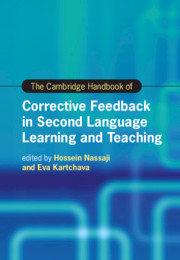21 results
Introduction - Corrective Feedback in Second Language Teaching and Learning
-
-
- Book:
- The Cambridge Handbook of Corrective Feedback in Second Language Learning and Teaching
- Published online:
- 26 February 2021
- Print publication:
- 11 March 2021, pp 1-20
-
- Chapter
- Export citation
Part I - Theoretical Perspectives on Corrective Feedback
-
- Book:
- The Cambridge Handbook of Corrective Feedback in Second Language Learning and Teaching
- Published online:
- 26 February 2021
- Print publication:
- 11 March 2021, pp 21-108
-
- Chapter
- Export citation
Part V - Corrective Feedback and Language Skills
-
- Book:
- The Cambridge Handbook of Corrective Feedback in Second Language Learning and Teaching
- Published online:
- 26 February 2021
- Print publication:
- 11 March 2021, pp 365-470
-
- Chapter
- Export citation
Contributors
-
- Book:
- The Cambridge Handbook of Corrective Feedback in Second Language Learning and Teaching
- Published online:
- 26 February 2021
- Print publication:
- 11 March 2021, pp xiii-xx
-
- Chapter
- Export citation
Figures
-
- Book:
- The Cambridge Handbook of Corrective Feedback in Second Language Learning and Teaching
- Published online:
- 26 February 2021
- Print publication:
- 11 March 2021, pp x-x
-
- Chapter
- Export citation
Copyright page
-
- Book:
- The Cambridge Handbook of Corrective Feedback in Second Language Learning and Teaching
- Published online:
- 26 February 2021
- Print publication:
- 11 March 2021, pp vi-vi
-
- Chapter
- Export citation
Index
-
- Book:
- The Cambridge Handbook of Corrective Feedback in Second Language Learning and Teaching
- Published online:
- 26 February 2021
- Print publication:
- 11 March 2021, pp 796-800
-
- Chapter
- Export citation
Part II - Methodological Approaches in the Study of Corrective Feedback
-
- Book:
- The Cambridge Handbook of Corrective Feedback in Second Language Learning and Teaching
- Published online:
- 26 February 2021
- Print publication:
- 11 March 2021, pp 109-184
-
- Chapter
- Export citation
28 - The Role of Training in Feedback Provision and Effectiveness
- from Part VII - Learners’ and Teachers’ Feedback Perspectives, Perceptions, and Preferences
-
-
- Book:
- The Cambridge Handbook of Corrective Feedback in Second Language Learning and Teaching
- Published online:
- 26 February 2021
- Print publication:
- 11 March 2021, pp 598-619
-
- Chapter
- Export citation
Part IV - Feedback Provider, Feedback Intensity, and Feedback Timing
-
- Book:
- The Cambridge Handbook of Corrective Feedback in Second Language Learning and Teaching
- Published online:
- 26 February 2021
- Print publication:
- 11 March 2021, pp 273-364
-
- Chapter
- Export citation
Part VI - Contexts of Corrective Feedback and Their Effects
-
- Book:
- The Cambridge Handbook of Corrective Feedback in Second Language Learning and Teaching
- Published online:
- 26 February 2021
- Print publication:
- 11 March 2021, pp 471-558
-
- Chapter
- Export citation
Part VIII - Individual Differences, Tasks, and Other Language- and Learner-Related Factors
-
- Book:
- The Cambridge Handbook of Corrective Feedback in Second Language Learning and Teaching
- Published online:
- 26 February 2021
- Print publication:
- 11 March 2021, pp 643-795
-
- Chapter
- Export citation
24 - Corrective Feedback in Mobile Technology-Mediated Contexts
- from Part VI - Contexts of Corrective Feedback and Their Effects
-
-
- Book:
- The Cambridge Handbook of Corrective Feedback in Second Language Learning and Teaching
- Published online:
- 26 February 2021
- Print publication:
- 11 March 2021, pp 520-538
-
- Chapter
- Export citation
Contents
-
- Book:
- The Cambridge Handbook of Corrective Feedback in Second Language Learning and Teaching
- Published online:
- 26 February 2021
- Print publication:
- 11 March 2021, pp vii-ix
-
- Chapter
- Export citation
Acknowledgments
-
- Book:
- The Cambridge Handbook of Corrective Feedback in Second Language Learning and Teaching
- Published online:
- 26 February 2021
- Print publication:
- 11 March 2021, pp xxi-xxii
-
- Chapter
- Export citation
Part VII - Learners’ and Teachers’ Feedback Perspectives, Perceptions, and Preferences
-
- Book:
- The Cambridge Handbook of Corrective Feedback in Second Language Learning and Teaching
- Published online:
- 26 February 2021
- Print publication:
- 11 March 2021, pp 559-642
-
- Chapter
- Export citation
Part III - Different Delivery Modes of Corrective Feedback
-
- Book:
- The Cambridge Handbook of Corrective Feedback in Second Language Learning and Teaching
- Published online:
- 26 February 2021
- Print publication:
- 11 March 2021, pp 185-272
-
- Chapter
- Export citation
Tables
-
- Book:
- The Cambridge Handbook of Corrective Feedback in Second Language Learning and Teaching
- Published online:
- 26 February 2021
- Print publication:
- 11 March 2021, pp xi-xii
-
- Chapter
- Export citation

The Cambridge Handbook of Corrective Feedback in Second Language Learning and Teaching
-
- Published online:
- 26 February 2021
- Print publication:
- 11 March 2021
12 - Corrective Feedback and Good Language Teachers
- from Part II - Classroom Perspectives
-
-
- Book:
- Lessons from Good Language Teachers
- Published online:
- 22 April 2020
- Print publication:
- 30 April 2020, pp 151-163
-
- Chapter
- Export citation

